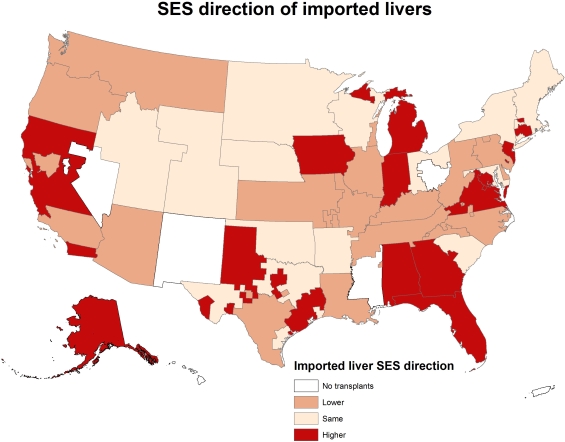Socioeconomic Status of Local Vs Exported Liver Recipients and Their Donors
J. Adler,1 J. Hyder,2 J. Markmann,1 H. Yeh.1
1Massachusetts General Hospital, Boston, MA
2Mayo Clinic, Rochester, MN.
Meeting: 2015 American Transplant Congress
Abstract number: 266
Session Information
Session Name: Concurrent Session: Disparities in Healthcare Access
Session Type: Concurrent Session
Date: Monday, May 4, 2015
Session Time: 4:00pm-5:30pm
 Presentation Time: 4:48pm-5:00pm
Presentation Time: 4:48pm-5:00pm
Location: Room 115-C
INTRODUCTION: Broader sharing has been proposed as a solution to decrease geographic disparities in liver transplantation, with the hope that this will also neutralize the advantage that higher socioeconomic status (SES) offers for listing outside one's home Donation Service Area (DSA). We therefore examined current patterns of ethnicity and SES in donors and recipients, comparing livers transplanted within their DSA of procurement to those transplanted outside the procuring DSA (exports).
METHODS: The Scientific Registry of Transplant Recipients was queried for adult deceased donors and liver transplant recipients from 2007-2012 (29,764 total). An SES index was estimated from zip code-level US census data. Adjusted liver donor risk index (aLDRI) was calculated by excluding sharing and cold ischemia time. Disparities were tested using an organ flow method comparing matched donor and recipient pairs. A difference-in-difference estimate was used to test for differences between recipients' SES.
RESULTS: Compared to donors, recipients were more commonly White (71.4% vs. 66.0%, P<0.001) and older (54.2±0.1 vs. 41.7±0.1 years, P<0.001) with a slightly higher average SES index (51.1±0.03 vs. 50.2±0.03, P<0.001). In the organ flow analysis, recipients tended to be of the same ethnic group as the donor (P<0.001), but had a higher SES index (difference 0.90±0.04, P<0.001). Exported livers were of lower quality (aLDRI, 1.44±0.004 vs. 1.38±0.002 , P=0.01), but went to recipients of a higher SES index compared to locally transplanted livers (difference-in-difference 2.8±0.7, P<0.001).
CONCLUSIONS: In general, livers go to recipients of higher SES than the donor, the opposite of what has been demonstrated in kidney transplantation. This SES disparity was greater for exported livers, even though they were of lower quality than those transplanted locally. Further work is being done to determine the mechanisms of these observations, and to understand how SES and ethnic disparities would change with various organ sharing plans.
To cite this abstract in AMA style:
Adler J, Hyder J, Markmann J, Yeh H. Socioeconomic Status of Local Vs Exported Liver Recipients and Their Donors [abstract]. Am J Transplant. 2015; 15 (suppl 3). https://atcmeetingabstracts.com/abstract/socioeconomic-status-of-local-vs-exported-liver-recipients-and-their-donors/. Accessed December 14, 2025.« Back to 2015 American Transplant Congress
